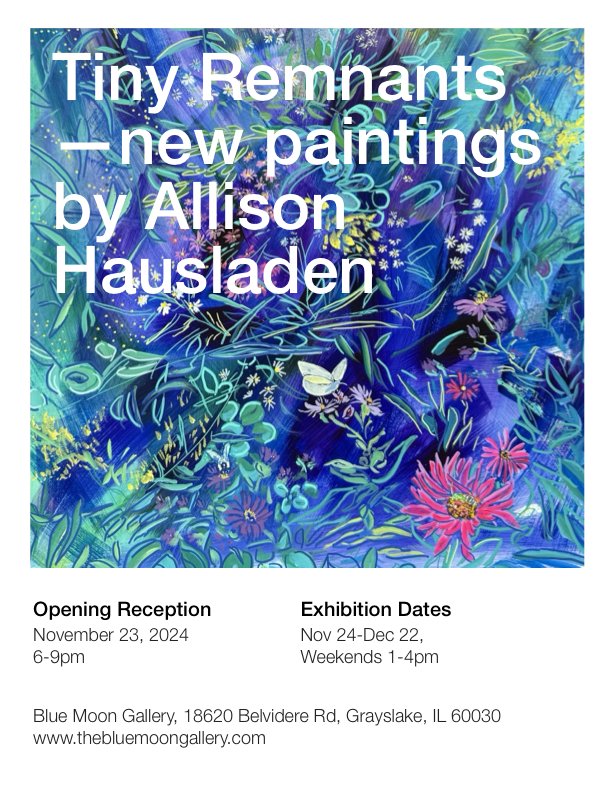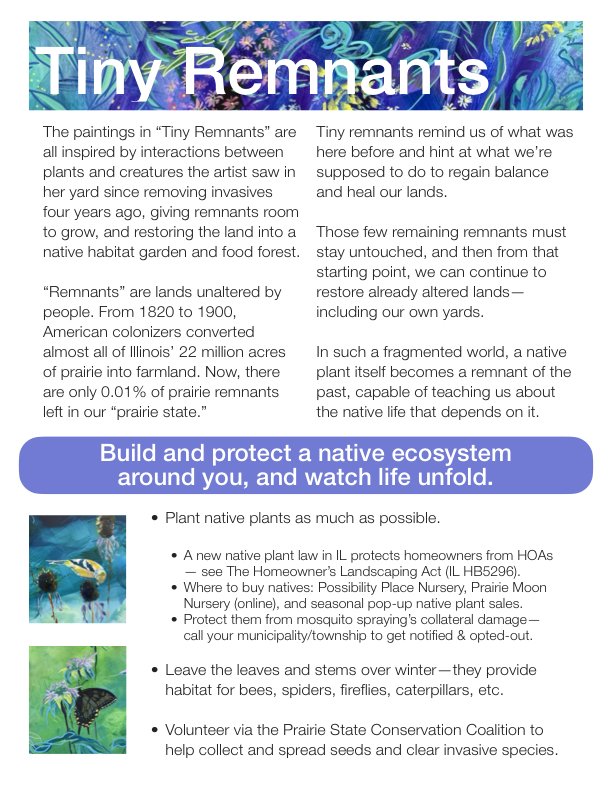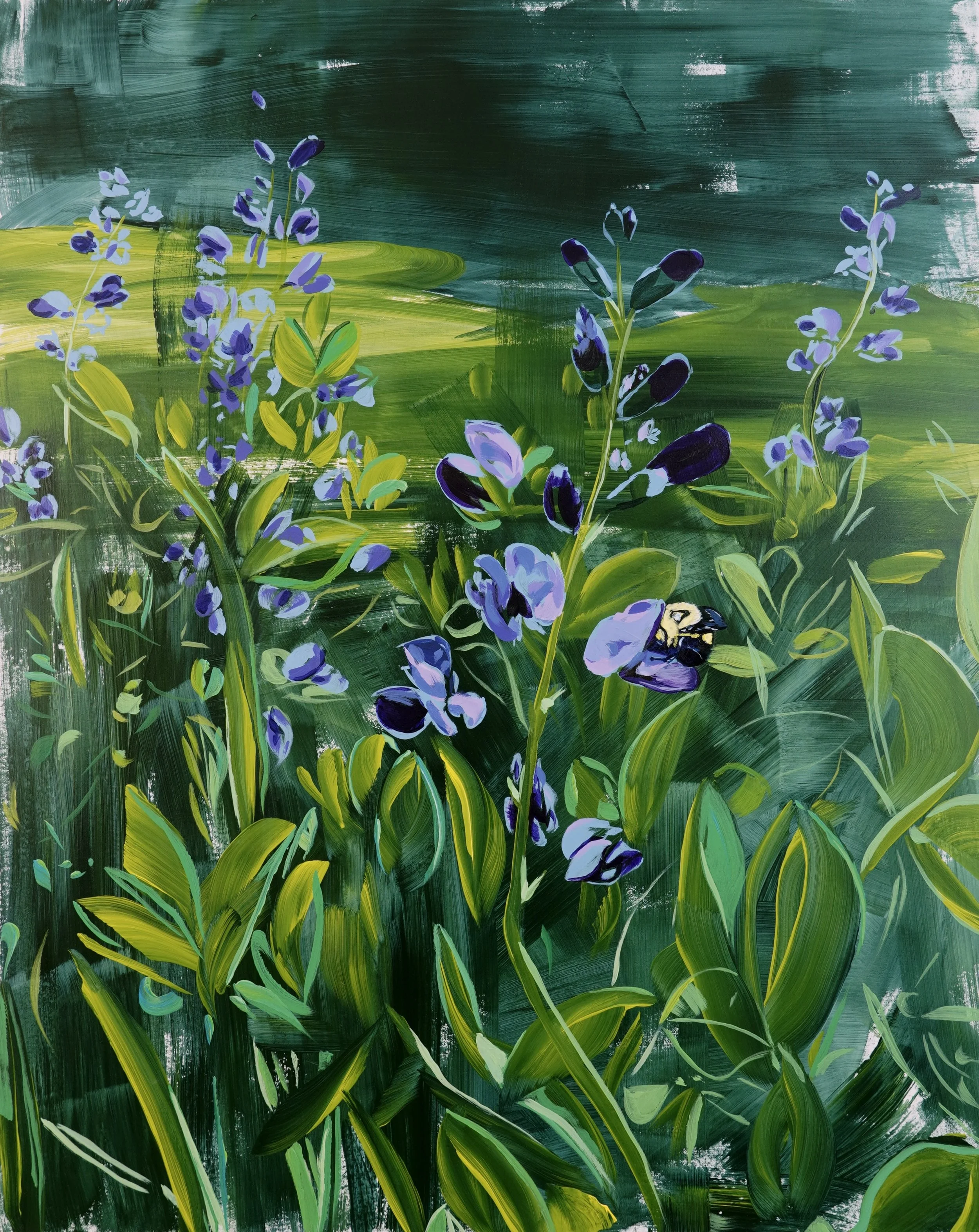Tiny Remnants
The paintings in “Tiny Remnants” are all inspired by interactions between plants and creatures I saw in my yard since removing invasives four years ago, giving remnants room to grow, and restoring the land into a native habitat garden and food forest.
This painting series is on display from November 23rd-December 21, 2024 at Blue Moon Gallery in Grayslake, IL.
2024, acrylic on cradled board, 16” wide x 20” high


The Bloodroot and the Ant (March)
The Bloodroot splits the woodland’s leafy floor first, its leaves unfurling, signaling spring’s arrival. Patiently waiting decades for invasive buckthorn to be removed, it feels the sun. Later in spring, ants spread its seeds a couple yards over, rewarded with their jelly coating. The waiting is worth it. Life begins again.
The Virginia Bluebells and the Bumblebee (April)
The breeze sways the leaves, ringing the bells. Can the bumblebees hear this song? Do they see the periwinkle and know there’s a tasty gift as we do? By summer, they vanish, making room for others as the seeds they spread and bulbs wait to form a sea of blue.
The Blue Wild Indigo and the Bumblebee (May)
Appearing from nowhere, the shrub-like wild indigo’s leaves stay vibrant green until frost. Bubbles of indigo light a torch for the bumblebee whose strong body is one of the few able to pry open the pea-like flowers. In fall, the bean-like dried seed pods rattle, then pop, sprinkling a generation.
The Pale Purple Coneflowers and the Firefly (June)
In dusk’s blue light, the pale purple coneflowers glow like neon, pedals so new they point upright still. A firefly prepares for flight, spreading his wings, then glowing, his day and season of flying beginning after careful wintering under the leaves, dining on slugs and earthworms as larva. It’s time.
The Wild Bergamot and the Eastern Tiger Swallowtail (July)
Wild bergamot’s nectar flows at the end of its long bloom, delighting the dark morph female eastern tiger, who traded yellow for black to look like her toxic pipevine cousin. Did her life begin here, eating magnolia, birch, ash, or wild cherry leaves, disguised as bird droppings then a snake?
The Common Milkweed and the Threatened Monarch Caterpillar (July)
Outsmarting and outlucking ants, earwigs, spiders, and pesticides to reach her 5th instar skin, the monarch looks up at the human gasping in delight, then munches the leaves of the only plant she can digest, the once-common milkweed. With wings, she’ll sip nectar, mate, and lay eggs on every milkweed she finds.
The Anise Hyssop and the Hummingbird (July)
Seeded under the skirt of a tall evergreen tree, the anise hyssop’s tiny purple flowers attract many, including a ruby-throated hummingbird who camouflages well against its licorice leaves as she daintily hovers from top to side, moving her way down. And in a quick hum, she’s gone.
The Black-Eyed Susan’s and the Fraternal Potter Wasp (August)
In a bouquet of black-eyed Susan's sits a pot thrown from mud. An impossibly thin wasp emerges from the house made by his mother who filled it with live caterpillars before laying her egg and sealing the pot shut. Both predator and pollinator, the potter wasp is a gardener’s friend.
The Purple Coneflowers and the Goldfinch (September)
The goldfinch fuels diligently on dried purple coneflower seeds, undaunted by human noises a few yards away. For over an hour, she readies for fall, thankful for this cache in a sea of suburbia, that this patch is no longer grass. This is what it means to garden for wildlife.
The Asters, Goldenrod, and the Bicolored Sweat Bee (October)
A swirling mix of yellows, purples, pinks, and whites, the asters and the goldenrods attract the most pollinators—stronger together. I fear not for the first green sweat bee I’ve seen, the other bees, flies, butterflies and moths they attract because the mosquito spraying program has ended for the year.
“Remnants” are lands unaltered by people. From 1820 to 1900, American colonizers converted almost all of Illinois’ 22 million acres of prairie into farmland. Now, there are only 0.01% of prairie remnants left in our “prairie state.”
Tiny remnants remind us of what was here before and hint at what we’re supposed to do to regain balance and heal our lands. Those few remaining remnants must stay protected, and then from that starting point, we can continue to restore already altered lands—including our own yards. In such a fragmented world, a native plant itself becomes a remnant of the past, capable of teaching us about the native life that depends on it.
Build and protect a native ecosystem around you, and watch life unfold.
Plant native plants as much as possible.
A new native plant law in IL protects homeowners from HOAs — see The Homeowner’s Native Landscaping Act (IL HB5296).
Where to buy natives: Possibility Place Nursery, Prairie Moon Nursery (online), seasonal pop-up native plant sales, and some local nurseries carry some (e.g. Country Bumpkin in Mundelein, IL).
To learn more about going native in your own yard, contact Openlands about their Conservation@Home program.
Protect the plants and the invertebrates they attract from mosquito spraying’s collateral damage—call your municipality/township to get notified & opted-out. See here for more information.
Leave the leaves and stems over winter—they provide habitat for bees, spiders, fireflies, caterpillars, etc.
Volunteer via the Prairie State Conservation Coalition to help collect and spread seeds and clear invasive species.
Become a citizen scientist to help researchers in conservation. For instance, you can help count monarch eggs, caterpillars and milkweed plants via the Monarch Larva Monitoring Project. Click the link for training information. Time commitment: about an hour each week over the summer.









